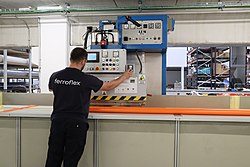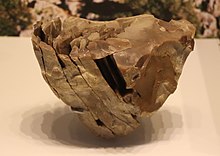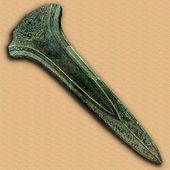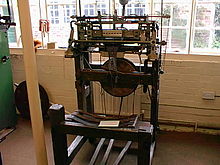Manufacture
Manufacturing or manufacturing is a phase of the economic production of goods. The term can refer to a range of human activities, from crafts to high technology, but is most commonly applied to industrial production, which involves the transformation of raw materials into manufactured products, processed products or finished products for distribution and consumption on a large scale. It also involves manufacturing processes of semi-manufactured products or semi-finished products.
Manufacturing engineering or the manufacturing process are the steps through which raw materials are transformed into a final product. The manufacturing process begins with the design of the product and the specification of the materials from which the product is made. These materials are modified through manufacturing processes to become the required part.
Manufacturing is the activity of the secondary sector of the economy, also called the industrial sector, manufacturing sector, or simply manufacturing or industry.
The manufacturing sector is closely related to engineering and industrial design. Some examples of major manufacturers in North America are General Motors Corporation, General Electric, Procter & Gamble, General Dynamics, Boeing, Pfizer, and Precision Castparts. Examples in Europe include Volkswagen Group, Siemens, FCA and Michelin. Examples in Asia include Toyota, Yamaha, Panasonic, Mitsubishi, LG, and Samsung.
Varieties of the term manufacturing
Initially, manufacturing means a stage in the development of capitalism in which production was done by hand, that is, production of objects without the intervention of machines; In this form of production, unlike the artisan workshop, the object is not produced by a single person, but by a group of them, each of whom performs one or another operation, which leads to a rapid increase in the productivity of the work, compared to the craftsman.
The term can refer to a variety of human activities, from crafts to high technology, but is most commonly applied to industrial production, in which raw materials are transformed into goods. finished on a large scale and with the use of machines and energy sources beyond the simple work of man.
In the Old Regime, the denomination manufacturing, and specifically the Royal Manufactures, was in practice opposed both to the facilities of the trade union workshops and to the first factories (which were the area where the Industrial Revolution took place. Manufacturing in the sense of manufacturing occurs under all types of economic systems, and it is an activity so typical of the human being that it defines it as a species, being the remains of material culture of the Paleolithic, the first testimonies of human presence on earth, as they are even more resistant than anatomical remains.
In the capitalist economic system, manufacturing is directed, through the free market and free enterprise, towards the mass production of products for sale to a mass market of consumers (consumer society). In the countries of the so-called real socialism, which sought to build a socialist mode of production, manufacturing was directed by a state agency (planning), and heavy industry was privileged over consumer goods. In modern economies, manufacturing occurs under some degree of government regulation.
Modern manufacturing includes all the intermediate processes required for the production and integration of the components of a product. The industrial sector is closely related to engineering and industrial design.
The process can be manual (origin of the term) or with the use of machines. To obtain a greater volume of production, the division of labor technique is applied, where each worker performs only a small portion of the task. Thus, it specializes and economizes movements, which will result in a higher production speed.
Although craft production has been part of humanity for a long time (since the Middle Ages), modern manufacturing is thought to have emerged around 1780 with the British Industrial Revolution, expanding from then on to all of Continental Europe, then to North America and finally to the rest of the world.
The Venice Arsenal offers one of the earliest examples of a manufacturing company in the modern sense, founded in 1104 in Venice; it produced almost a ship every day and at its peak had 16,000 specialized employees.
Manufacturing has become a huge portion of the modern world economy. According to some economists, manufacturing is a wealth-producing sector in an economy, while the service sector tends to be the consumption of wealth.
History and development
Prehistory and ancient history
Human ancestors have made objects with stone and other tools since long before the appearance of Homo sapiens approximately 200,000 years ago. The earliest methods of stone tool making, known as & #34;industry" Olduvayan, dates back to at least 2.3 million years ago, with the first direct evidence of tool use found in Ethiopia in the Great Rift Valley, dating back to 2.5 million years ago. To craft a stone tool, a "core" hard stone with specific flaking properties (such as flint) was struck with a hammer. This flaking produced sharp edges that could be used as tools, mainly in the form of a pick or scraper. These tools greatly assisted early humans in their hunter-gatherer lifestyle to form other tools from softer materials such as bone and wood. The Middle Paleolithic, approximately 300,000 years ago, saw the introduction of the prepared-core technique, where multiple sheets could be rapidly formed from a single-core stone., in which a wood, bone, or antler awl that could be used to shape a stone very finely developed during the Upper Paleolithic, beginning about 40,000 years ago. During the Neolithic, neat stone tools became They were made from various hard rocks such as flint, jade, jadeite, and green shale. The neat axes were used alongside other stone tools, including spikes, knives, and scrapers, as well as tools made from organic materials such as wood, bone, and horn.
Copper smelting is believed to have originated when kiln pottery technology allowed for fairly high temperatures. The concentration of various elements, such as arsenic, increases with depth in copper and mineral ore deposits. the smelt of these arsenic bronze ores, which can be hardened enough to be worked into tools. Bronze is an alloy of copper with tin; the latter, found in relatively few deposits worldwide, caused it to be a long time before real tin bronze became widespread. During the Bronze Age, bronze was a major advance over stone as a tool-making material, both because of its mechanical properties such as strength and ductility, and because it could be cast in molds to make intricately shaped objects. The bronze significantly advanced shipbuilding technology with better bronze tools and keys, which replaced the older method of hooking hull planks with woven cord through punched holes. The Iron Age is conventionally defined by the widespread manufacture of weapons and tools that use iron and steel instead of bronze. Casting iron is more difficult than casting tin and copper, since cast iron requires hot working and can only be melted in specially designed furnaces. The place and time of the discovery of iron smelting is not known, partly because of the difficulty of distinguishing metal extracted from nickel-bearing ores from hot-worked meteoritic iron.
During the growth of ancient civilizations, many ancient technologies resulted from advances in manufacturing. Several of the six classical simple machines were invented in Mesopotamia. Mesopotamians have been credited with the invention of the wheel. The wheel mechanism first appeared with the potter's wheel, invented in Mesopotamia (present-day Iraq) during the 5th millennium BC. Egyptian paper made from papyri, as well as clay, were mass-produced and exported throughout the world. Mediterranean basin. The first construction techniques used by the ancient Egyptians made use of bricks composed primarily of clay, sand, silt, and other minerals.
Medieval and Early Modern
The medieval age saw a sea change in the rate of new inventions, innovations in the way traditional means of production were managed, and economic growth. Papermaking, a Chinese technology of the II century, was brought to the Middle East when a group of Chinese papermakers were captured in the 8th century century. Paper-making technology spread to Europe with the Umayyad conquest of Spain. In the 12th century a paper mill was established in Sicily. In Europe the fiber to make pulp for making paper was obtained from linen and cotton rags. Lynn Townsend White Jr. credited the spinning wheel with increasing the supply of rags, which led to cheap paper, which was a factor in the development of printing. Due to the rise of cannons, the blast furnace became a widespread use in France in the mid-XV century century. The blast furnace had been used in China since the IV century BCE. C.. The stocking machine, which was invented in 1598, increased the number of knitters per minute from 100 to 1,000.
First and second industrial revolutions
The Industrial Revolution was the transition to new manufacturing processes in Europe and the United States from the 1760s to the 1830s. This transition included the shift from manual to machine production methods, new chemical industry processes, and the production of iron, the increasing use of the steam engine and hydraulic power, the development of machine tools, and the rise of the mechanized manufacturing system. The Industrial Revolution also caused an unprecedented increase in the rate of population growth. Textile was the dominant industry of the Industrial Revolution in terms of employment, production value, and capital investment. The textile industry was also the first to use modern production methods. Rapid industrialization first began in Britain, beginning with mechanized spinning in the 1780s, with high rates of growth in iron and steam production. that were produced beginning in the 1800s. Mechanized textile production spread from Great Britain to continental Europe and the United States in the early 19th century. , with important textile, iron and coal centers emerging in Belgium and the United States and later textiles in France.
An economic recession occurred from the late 1830s to the early 1840s, as adoption of the early innovations of the Industrial Revolution, such as mechanized spinning and weaving, lagged and their markets matured. Innovations developed late in the period, such as the increasing adoption of locomotives, steamships, and hot iron casting, and new technologies, such as the electric telegraph, widely introduced in the 1840s and 1850s, were not enough. powerful to drive high growth rates. The rapid economic growth began to take place from 1870, which arose from a new group of innovations in what has been called the Second Industrial Revolution. These innovations included new steelmaking processes, mass and line production, electrical grid systems, the large-scale manufacturing of machine tools, and the use of increasingly advanced machinery in steam factories.
Taking advantage of improvements in materials research and vacuum pumps, electric lamps became practical for general use in the late 1870s. This invention had a profound effect on the workplace because factories could now have second and third shift workers. Shoe production became mechanized in the mid-19th century. Mass production of machines Sewing machines and farm machinery such as reapers were produced in the mid-19th century. Bicycles were mass-produced from the 1880s. Steam factories became widespread, although the conversion of water to steam occurred in England before it did in the US.
Modern Manufacturing
The electrification of factories, which had begun gradually in the 1890s after the introduction of the practical DC and AC motor, was most rapid between 1900 and 1930, aided by the establishment of electrical services with central stations and the lowering of electricity prices between 1914 and 1917. Electric motors allowed greater flexibility in manufacturing and required less maintenance than line shafts and belts. Many factories experienced a 30% increase in production just by moving to electric motors. Electrification enabled modern mass production, and the greatest impact of early mass production was in the manufacture of everyday products, such as the Ball Brothers Glass Manufacturing Company, which electrified its terrine plant in Muncie, Indiana, USA towards the 1900s. The new automated process used glassblowing machines to replace 210 blowtorches and artisan glass helpers. A small electric truck was used to handle 150 dozen bottles at a time, where previously one truck would bring in 6 dozen. Electric mixers replaced the men who manipulated sand and other ingredients that were introduced into the glass oven with shovels. An electric overhead crane replaced 36 laborers to move heavy loads throughout the factory.
Mass production was popularized in the late 1910s and 1920s by Henry Ford's Ford Motor Company, which introduced electric motors in what was then known as sequential production. Ford also purchased or designed and built special-purpose machine tools and accessories, such as multi-spindle drill presses that could drill all the holes in one side of an engine block in one operation and a multi-head milling machine that could machine simultaneously 15 engine blocks fastened in a single device. All of these machine tools were arranged systematically in the production flow, and some had special carriages for rolling heavy components into machining position. Production of the Ford Model T used 32,000 machine tools.
Lean production (also known as just-in-time manufacturing), which is a production method aimed primarily at reducing times within the production system, as well as supplier and customer response times, it was developed at Toyota in Japan in the 1930s. It was introduced to Australia in the 1950s by the British Motor Corporation (Australia) at the Victoria Park plant in Sydney, from where the idea later migrated to Toyota. News spread to Western countries from Japan in 1977 in two articles in English: one referred to the methodology as the 'Ohno system', by Taiichi Ohno, who was instrumental in its development within Toyota. The other article, published by Toyota authors in an international journal, provided additional details. Eventually, that publicity and others resulted in implementations, beginning in 1980 and then rapidly multiplying throughout the world. to industry in the United States and other countries.
List of countries by manufacturing production
These are the top 50 countries according to the total value of manufacturing production in US dollars for their detailed year according to the World Bank.
Manufacturing systems
- Artisanal production
- Putting-out system
- English manufacturing system
- American manufacturing system
- Soviet collectivism in manufacturing
- Mass production
- Chain or continuous production
- batch or discontinuous production
- Manufacture by order
- Manufacturing Just time
- Monozukuri
- Toyota Production System
- Lean manufacturing
- Flexible manufacturing
- Mass customization
- Agile manufacturing
- Rapid Manufacturing
- Prefabrication
- Property
- Publication
Manufacturing categories
- Chemical industry
- Pharmaceutical
- Construction
- Electronics
- Semiconductors
- Engineering
- Biotechnology
- Emerging technologies
- Nanotechnology
- Synthetic biology, Bioengineering
- Energy industry
- Food and Drink
- Agro-negocios
- Cervece industry
- Food processing
- Industrial design
- Interchangeable parts
- Metal industry
- Herrería
- Machinery
- Machine tools
- Machinability
- Manufacturer of tools and matrices
- Trends in the world steel industry
- Steel industry
- Foundry
- Plastics
- Telecommunications
- Textile manufacturing
- Textile industry
- Sailing
- Manufacture of tents
- Transport
- Aerospace manufacturing
- Car manufacturing
- Manufacture of buses
- Pneumatic manufacturing
Contenido relacionado
Economy of Brazil
Microeconomics
Francis Edgeworth





